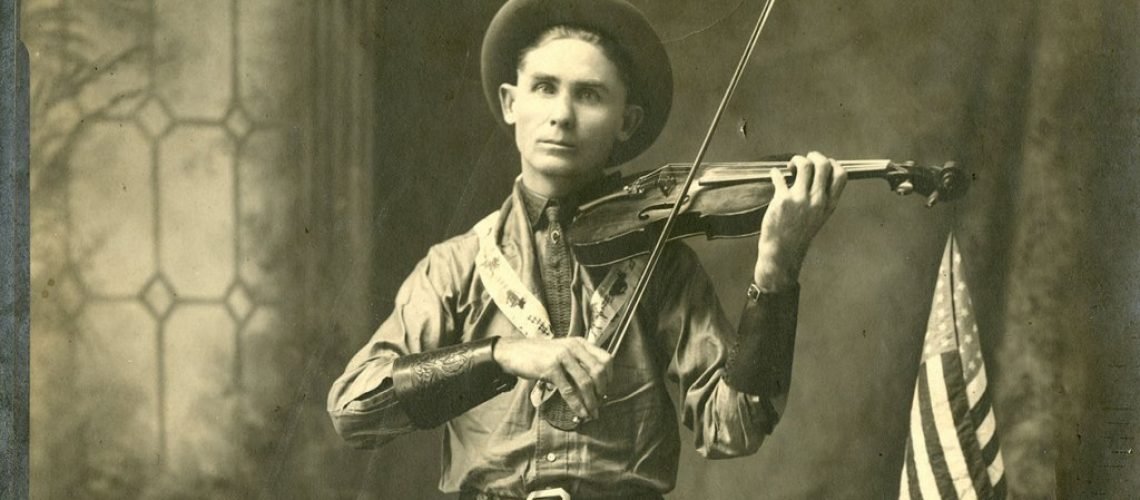When River House/Columbia Nashville released Luke Combs’ “The Kind of Love We Make” on June 17, the single employed a fierce lead vocal, two-part harmonies and around 10 different instruments, all apparent in their own clean, digital audio lane.
The performance shows how far the country recording business has come in 100 years. On June 30, 1922, a pair of fiddlers — Henry Gilliland and A.C. “Eck” Robertson — held what is widely regarded as the first country recording session at Victor Studios in New York.
They had no chance to overdub a bad note here or there, to correct poor pitch or to amplify one of the fiddlers later. They had to capture the entire three-minute performance in one sitting or start all over again, playing into a bell-shaped audio horn, with the sound’s vibrations translated through a needle that cut a groove into a wax disc. And they had to position themselves properly in the room with no ability for anyone to know what kind of quality they were getting until the performance was done.
“If you were recording a band, the loud instruments would be at the back, and the softer instruments would be in the front,” says Country Music Hall of Fame and Museum curator of recorded sound collections Alan Stoker. “They would have some platform set up in front of this very large horn, and some of them were 10 feet tall.”
The recordings from that era also “have a pretty poor sound,” Stoker allows.
Nonetheless, Gilliland and Robertson made history, showing up unannounced at Victor Studios on June 29 near the start of a visit with a friend of Gilliland, attorney Martin W. Littleton, a former congressman who likely had connections with Victor executives. The fiddlers had recently performed for a Confederate veterans reunion in Richmond, Va. (Gilliland was himself a former Confederate soldier, as was Robertson’s father.)
Much about the actual session is shrouded in mystery, according to Hall of Fame and Museum historian/editor Patrick Huber. It’s not clear which fiddler is playing lead, it’s uncertain if they were wearing out-of-place Confederate uniforms or cowboy duds, and there’s also some fuzziness about the release of the first two recordings: “Arkansaw Traveler” and the flip side, Robertson’s version of “Sallie Gooden” (a title referenced in John Denver’s “Thank God I’m a Country Boy”), which Robertson recorded on July 1 with a pianist.
“It’s released in April of 1923, and we don’t know why Victor waited so long to release that coupling,” Huber says. “Usually, companies released records about two to three months after they were cut.”
The whiny fiddles and crackly sound quality of “Arkansaw Traveler” beat the first country vocal recording, Fiddlin’ John Carson’s “The Little Old Log Cabin in the Lane,” to market by just a few months, but it was the first in a series of developments that advanced the recorded sound of country. Those shifts include:
— The introduction of electrical recording in the mid-1920s, which improved sound quality and evened out the speed of recordings. It introduced microphones into the process and made it possible to better capture certain frequencies and sounds, such as the sibilant letter “s.”
— Multitrack recording emerged as a result of World War II, when Germans figured out how to employ magnetic tape to preserve sound and, in turn, broadcast propaganda. An American adapted the technology to sound recording, which led to splicing tape and other means of fixing portions of a performance.
— Les Paul learned to layer guitar harmonies with the advent of tape, an adaptation that was successfully applied to vocals by artists including his wife, Mary Ford, who delivered the 1951 country hit “Mockin’ Bird Hill,” and Patti Page, who doubled her own voice on “Tennessee Waltz.”
— Standardized equalization was introduced around 1955, tightening labels’ adherence to specific RPMs. As a result, recordings better represented the bass, which had previously been fairly elusive. “Really, what they do is they decrease the amount of bass going in, and they increase it coming out,” Stoker says. “It would keep the needle from jumping into the adjacent groove.”
— The use of headphones became more common in the late 1960s and 1970s. Late engineer Jim Williamson believed he was the first to use them in Nashville, to facilitate orchestral overdubs on the 1964 album Hank Williams With Strings. But even he was uncertain of that precedent, which — by eliminating the need for a speaker — allows musicians to perform in a booth without the other music leaking into their track.
— The digitization of music, beginning in the 1980s, brought further clarity to recording, though it also made the sound harsh to some developed ears. It made it even easier to collect more takes for a recording and to “fly” pieces of a performance — to take a guitar line, for example, from the last chorus and insert it into the intro.
— The infusion of DIY programming systems, such as ProTools or GarageBand, made it cheap and easy to record at home or other informal locales. (Cole Swindell’s first hit, “Chillin’ It,” cost less than $1,000 to make.) It hurt traditional recording studios, but it also made it possible for creatives to explore a larger variety of sounds with the proliferation of plug-in audio programs.
Thus, a century down the line, the crude-sounding recording process that a couple of old-time fiddlers first adapted to country has turned into a mega-business full of artists, producers and engineers who can work with a greater independence than could have been conceived in 1922. Combs, whose Sony recordings are now owned by the same corporation that captured the first country session, cut and charted his first recordings before he ever met with a major label.
“People can record their own hit record in their basement if they want to, or in the garage, and they don’t have to go through the gatekeepers that people like Robertson and Gilliland had to when record companies closely controlled who recorded, what they recorded and if it was released,” Huber notes. “Those are significant changes. It’s just opened up the industry in ways that would have previously been unimaginable.”
Subscribe to Billboard Country Update, the industry’s must-have source for news, charts, analysis and features. Sign up for free delivery every Monday.




